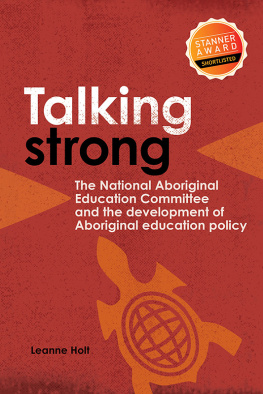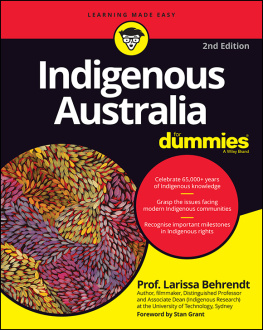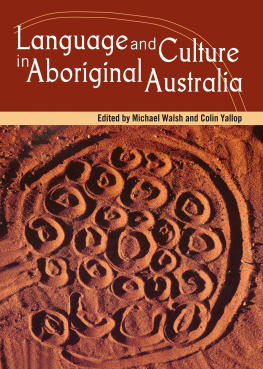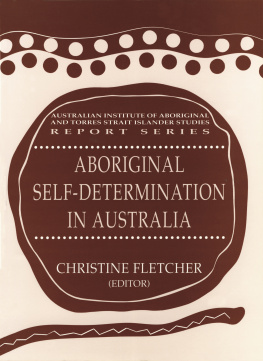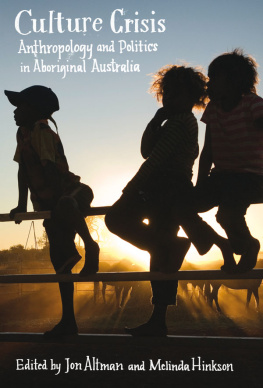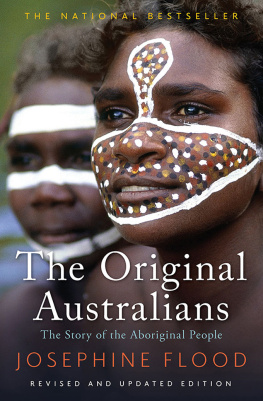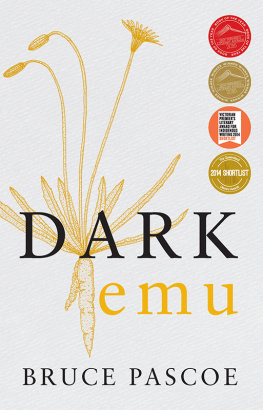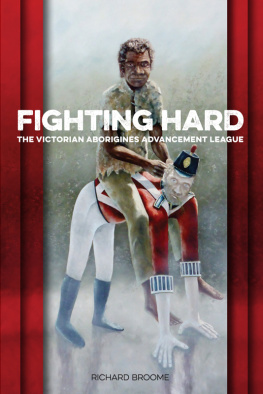Leanne is really courageous to write about the NAEC. Weve been like the forgotten people and shes highlighted that and provided some balance. Being part of the NAEC rejuvenated my way of thinking and doing, inspired me to relearn my language, and to initiate a lot of things. Im happy I was part of the National Aboriginal Education Committee, thats where it all started. The only way is through education. Its all come back to me, from Leannes work, what the NAEC has given me. Its a big past and shes highlighted the whole of it. They deserve to be remembered.
UNCLE LAURIE PADMORE, DULGABARRA YIDINJI ELDER
In this beautifully written book we are taken on a journey that renders visible the hidden history of Aboriginal and Torres Strait Islander advocacy in education. This exciting book captures the very best of the formidable and indomitable spirit of those early education warriors who paved the way for many of us to follow. Dr Holts contribution is no less.
DISTINGUISHED PROFESSOR AILEEN MORETON-ROBINSON, GOENPUL, QUANDAMOOKA; OFFICE OF INDIGENOUS EDUCATION AND ENGAGEMENT, RMIT UNIVERSITY
Culturally grounded knowledge and the principle of self-determination are pivotal to the creation of culturally affirming and intellectually enriching education, the sort that are essential tools in the fight for Aboriginal and Torres Strait Islander rights and freedoms. Holts book Talking Strong is an important account of a seminal period in Aboriginal education history and policy development in Australia. Holt captures the essence of the transformative era of the NAEC and the narratives of triumph and trials shared by the key players places readers directly in the room of change and transformation. A must read.
PROFESSOR BOB MORGAN, GAMILARAAY; CONJOINT PROFESSOR, WOLLOTUKA INSTITUTE, UNIVERSITY OF NEWCASTLE

First published in 2021
by Aboriginal Studies Press
An AIATSIS Research Publication
Leanne Holt 2021
All rights reserved. No part of this book may be reproduced or transmitted in any form or by any means, electronic or mechanical, including photocopying, recording or by any information storage and retrieval system, without prior permission in writing from the publisher. The Australian Copyright Act 1968 (the Act) allows a maximum of one chapter or 10 per cent of this book, whichever is the greater, to be photocopied by any educational institution for its education purposes provided that the educational institution (or body that administers it) has given a remuneration notice to Copyright Agency Limited (CAL) under the Act.
The opinions expressed in this book are the authors own and do not necessarily reflect the view of AIATSIS or ASP.
The author and publisher have made every effort to trace the original copyholders of materials used in this book. If anyone has any further information, please contact the publisher.
Aboriginal and Torres Strait Islander people are respectfully advised that this publication contains names and images of deceased persons and culturally sensitive information.
Aboriginal Studies Press is the publishing arm of the Australian Institute of Aboriginal and Torres Strait Islander Studies.
GPO Box 553, Canberra, ACT 2601
Phone: (61 2) 6246 1183
Fax: (61 2) 6261 4288
Email:
Web: www.aiatsis.gov.au/asp/about.html

9781925302318 (pb)
9781925302394 (ePub)
FOREWORD
Talking Strong is what we do. Talking Strong takes us on a path that needed Aboriginal and Torres Strait Islander people to be talking strong, to start those baby steps.
Leanne Holt gives us Talking Strong: The National Aboriginal Education Committee and the development of Aboriginal and Torres Strait Islander education in Australia an engaging, well-researched volume, rich with anecdotes (some a bit embarrassing on my part) and some interesting information that has not seen the light of day before.
Pearl Duncan once said to me, We are so fortunate that we were born at the right time and have the opportunity to be involved in this almost magical experience. For many of us, membership of the National Aboriginal Education Committee provided a path that perhaps we never would have dreamed of. Personally, I could see what others were achieving and realised the possibilities. While my passion was for curriculum development, fuelled by membership of the NAECs curriculum subcommittee, Initial Teacher Education was a priority. While I had achieved my childhood hope of becoming a teacher, further study beckoned and I needed to gain a PhD in order to work in this area. It was through working in the higher education sector and membership of the National Aboriginal and Torres Strait Islander Higher Education Consortium that I met Leanne Holt, who at that time was located at The Wollotuka Institute, University of Newcastle.
When Leanne first mentioned that she was hoping to write a history of the National Aboriginal Education Committee, I was on one hand quite envious and on the other, delighted and excited that it would be done.
Participating in interviews with Leanne took me back to my first-ever encounter with the NAEC. At that time, I was a primary school teacher in Hobart, grappling with the inability to truth-tell in the school curriculum.
It was 1977.
On one particular day, I was reading the Mercury newspaper over my morning coffee when I came across what to me was the most amazing story with a photograph of Phil Stewart, Patsy Cameron, Colin Bourke and Stephen Albert, a photograph that is shown on page 39.
There was a meeting in Hobart! Not just any meeting, but a meeting of the National Aboriginal Education Committee! Naturally, I hightailed it to the meeting venue as soon as school was over for the day and as Patsy Cameron recounted in this volume, Thats when we first met Kaye Price. Kaye actually arrived at our accommodation that night... she said, Hey, here I am. Im an Aboriginal teacher. Im number two.
The Tasmanian Aboriginal Centre had not long been established and my best friend, Lennah West (Newson) and her mother, Auntie Ida, had invited me to become involved. Lennah often came to my classes to talk about things Aboriginal; she often told the students that, It doesnt matter how much milk you put in your tea, its still a cup of tea. The TAC nominated me for membership and you can imagine my principals astonishment to receive a call from Federal Minister for Aboriginal Affairs Fred Chaney congratulating me on my appointment.
The NAEC was a watershed in Australian education, not just in relation to Aboriginal and Torres Strait Islander histories and cultures, but for Australia as a whole. For the first time, a wide range of people started to pay attention and we as educators received a great deal of support from members of the non-Indigenous population. As Leanne recounts, Developing relationships with non-Indigenous people was an important initiative because it would have been impossible for the NAEC to achieve its goals without their support and collaboration. This support and collaboration remain a critical issue.
One of the most powerful things the NAEC did was to hold meetings at different locations across the country. Visible. Approachable. Community meetings at Yuendumu, Mer (Murray Island), Broome, Cape Barren Island. As Patsy says, Really early... we decided that we wanted to get out into communities. We wanted to go out not sit in Canberra and have meetings there in this big, flash place. Similarly, the NAEC conferences provided the biggest opportunity for Aboriginal and Torres Strait Islander people to network, to share and gain insights into different ways of working. Eleanor Bourke remembers, Those networks were invaluable... Always meant you had a contact somewhere you could talk to if you were looking for some information. You could use the network and thats just priceless really.
Next page
